Business Studies: Introduction to Information Technology Report
VerifiedAdded on 2023/01/05
|11
|3634
|51
Report
AI Summary
This report provides a comprehensive overview of Information Technology (IT) in the context of modern business, with a focus on the UK-based supermarket chain, Tesco. The introduction establishes the significance of IT in data management, decision-making, and its applications across various sectors. The literature review explores the role of IT in business management, its influence on competitive advantage, and different networking technologies. The analysis and discussion section delves into the role of IT in the success and failure of businesses, ethical and social issues associated with IT, and the importance of internet and intranet. The report differentiates between LAN, MAN, and WAN technologies. The report also examines ethical issues such as hacking and copyright infringement, as well as social issues related to social media and unauthorized access. The report concludes with a summary of key findings and references.
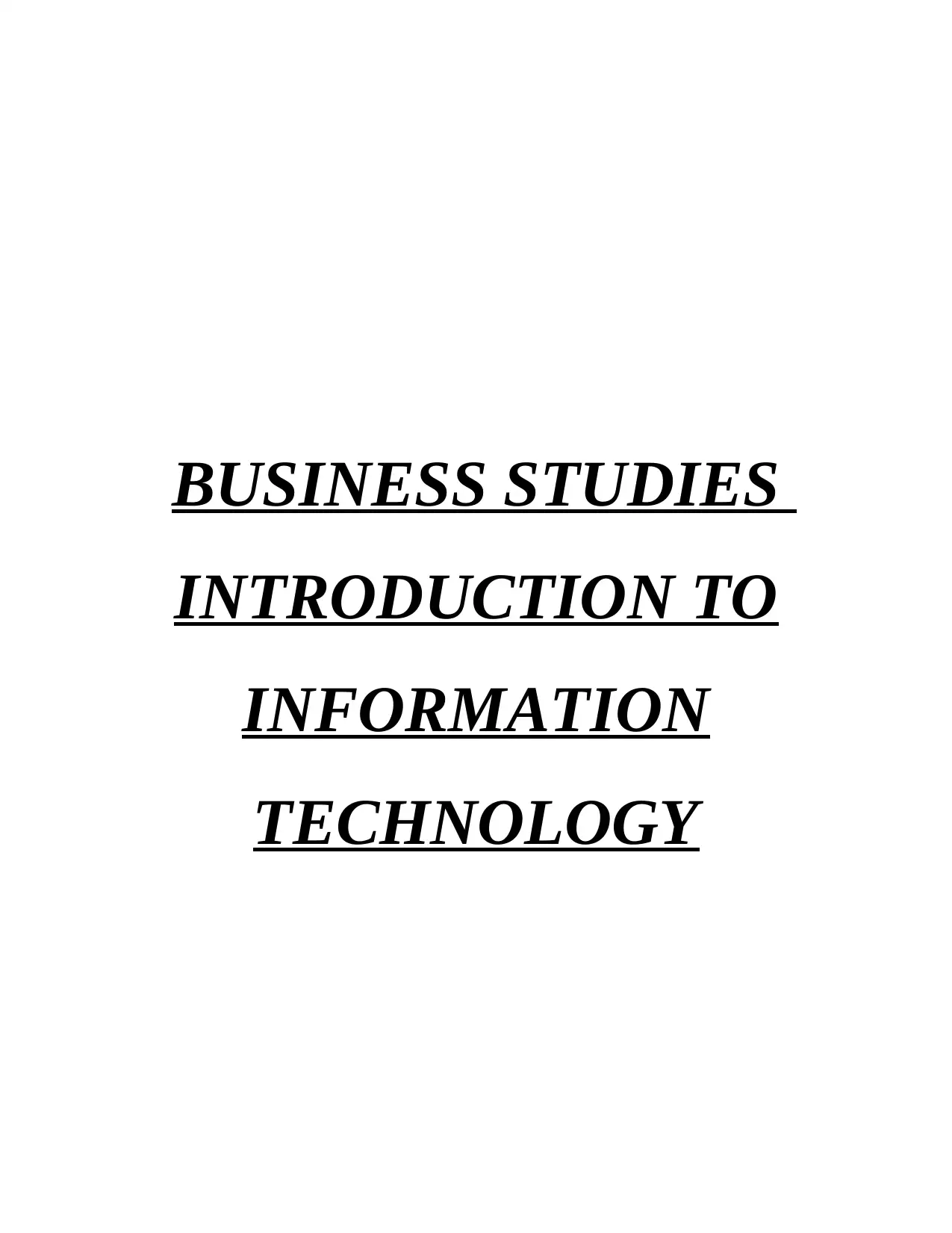
BUSINESS STUDIES
INTRODUCTION TO
INFORMATION
TECHNOLOGY
INTRODUCTION TO
INFORMATION
TECHNOLOGY
Paraphrase This Document
Need a fresh take? Get an instant paraphrase of this document with our AI Paraphraser
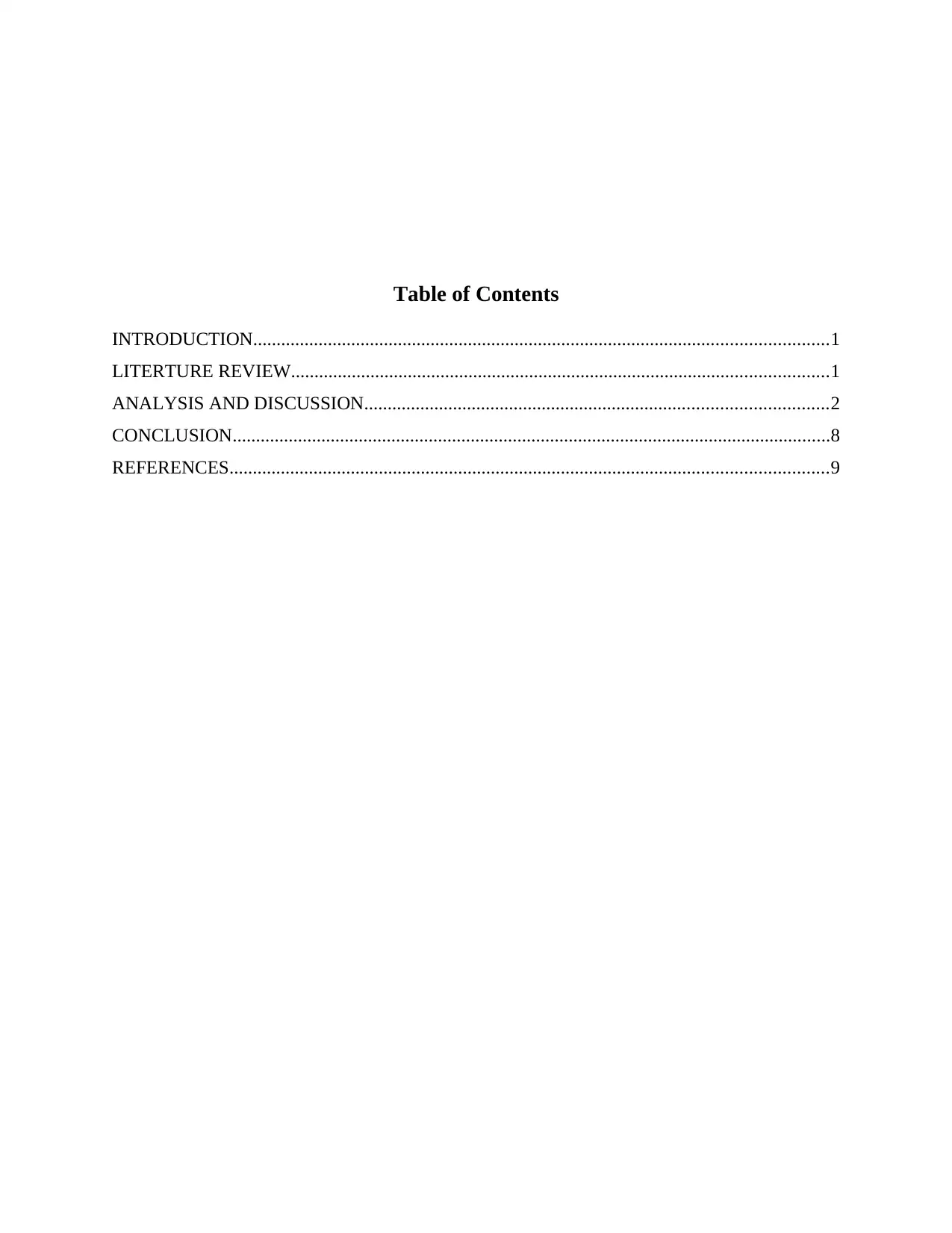
Table of Contents
INTRODUCTION...........................................................................................................................1
LITERTURE REVIEW...................................................................................................................1
ANALYSIS AND DISCUSSION...................................................................................................2
CONCLUSION................................................................................................................................8
REFERENCES................................................................................................................................9
INTRODUCTION...........................................................................................................................1
LITERTURE REVIEW...................................................................................................................1
ANALYSIS AND DISCUSSION...................................................................................................2
CONCLUSION................................................................................................................................8
REFERENCES................................................................................................................................9
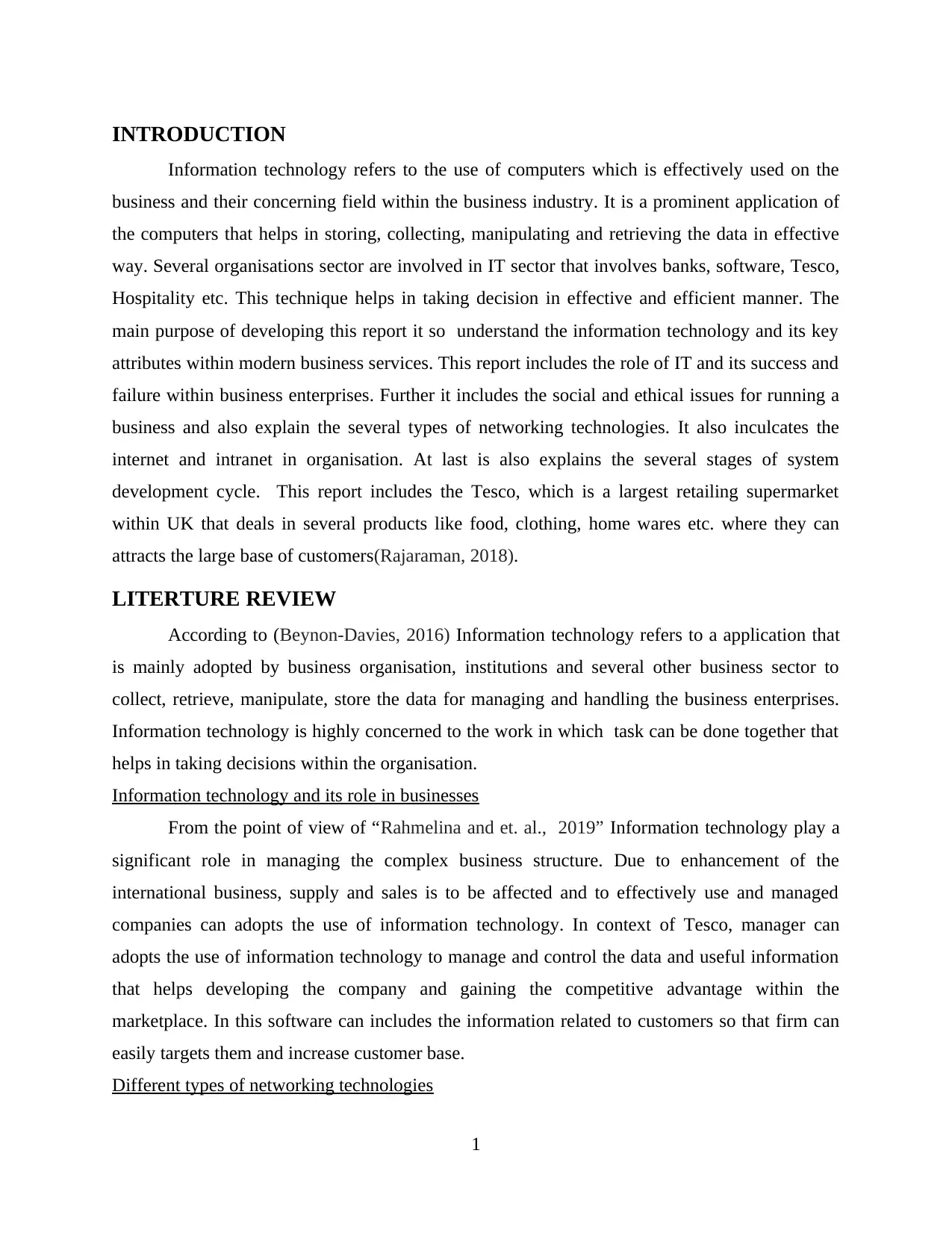
INTRODUCTION
Information technology refers to the use of computers which is effectively used on the
business and their concerning field within the business industry. It is a prominent application of
the computers that helps in storing, collecting, manipulating and retrieving the data in effective
way. Several organisations sector are involved in IT sector that involves banks, software, Tesco,
Hospitality etc. This technique helps in taking decision in effective and efficient manner. The
main purpose of developing this report it so understand the information technology and its key
attributes within modern business services. This report includes the role of IT and its success and
failure within business enterprises. Further it includes the social and ethical issues for running a
business and also explain the several types of networking technologies. It also inculcates the
internet and intranet in organisation. At last is also explains the several stages of system
development cycle. This report includes the Tesco, which is a largest retailing supermarket
within UK that deals in several products like food, clothing, home wares etc. where they can
attracts the large base of customers(Rajaraman, 2018).
LITERTURE REVIEW
According to (Beynon-Davies, 2016) Information technology refers to a application that
is mainly adopted by business organisation, institutions and several other business sector to
collect, retrieve, manipulate, store the data for managing and handling the business enterprises.
Information technology is highly concerned to the work in which task can be done together that
helps in taking decisions within the organisation.
Information technology and its role in businesses
From the point of view of “Rahmelina and et. al., 2019” Information technology play a
significant role in managing the complex business structure. Due to enhancement of the
international business, supply and sales is to be affected and to effectively use and managed
companies can adopts the use of information technology. In context of Tesco, manager can
adopts the use of information technology to manage and control the data and useful information
that helps developing the company and gaining the competitive advantage within the
marketplace. In this software can includes the information related to customers so that firm can
easily targets them and increase customer base.
Different types of networking technologies
1
Information technology refers to the use of computers which is effectively used on the
business and their concerning field within the business industry. It is a prominent application of
the computers that helps in storing, collecting, manipulating and retrieving the data in effective
way. Several organisations sector are involved in IT sector that involves banks, software, Tesco,
Hospitality etc. This technique helps in taking decision in effective and efficient manner. The
main purpose of developing this report it so understand the information technology and its key
attributes within modern business services. This report includes the role of IT and its success and
failure within business enterprises. Further it includes the social and ethical issues for running a
business and also explain the several types of networking technologies. It also inculcates the
internet and intranet in organisation. At last is also explains the several stages of system
development cycle. This report includes the Tesco, which is a largest retailing supermarket
within UK that deals in several products like food, clothing, home wares etc. where they can
attracts the large base of customers(Rajaraman, 2018).
LITERTURE REVIEW
According to (Beynon-Davies, 2016) Information technology refers to a application that
is mainly adopted by business organisation, institutions and several other business sector to
collect, retrieve, manipulate, store the data for managing and handling the business enterprises.
Information technology is highly concerned to the work in which task can be done together that
helps in taking decisions within the organisation.
Information technology and its role in businesses
From the point of view of “Rahmelina and et. al., 2019” Information technology play a
significant role in managing the complex business structure. Due to enhancement of the
international business, supply and sales is to be affected and to effectively use and managed
companies can adopts the use of information technology. In context of Tesco, manager can
adopts the use of information technology to manage and control the data and useful information
that helps developing the company and gaining the competitive advantage within the
marketplace. In this software can includes the information related to customers so that firm can
easily targets them and increase customer base.
Different types of networking technologies
1
⊘ This is a preview!⊘
Do you want full access?
Subscribe today to unlock all pages.

Trusted by 1+ million students worldwide
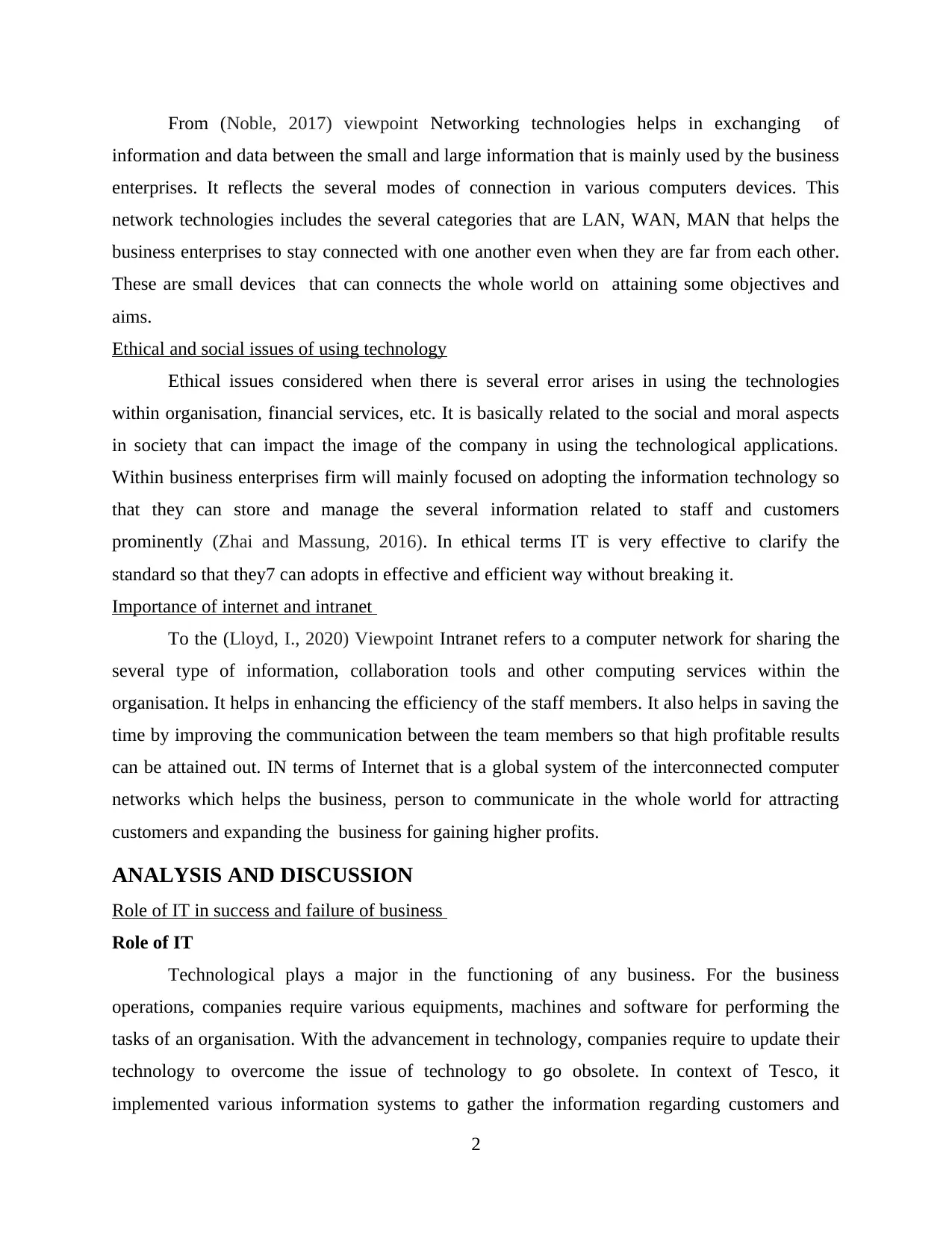
From (Noble, 2017) viewpoint Networking technologies helps in exchanging of
information and data between the small and large information that is mainly used by the business
enterprises. It reflects the several modes of connection in various computers devices. This
network technologies includes the several categories that are LAN, WAN, MAN that helps the
business enterprises to stay connected with one another even when they are far from each other.
These are small devices that can connects the whole world on attaining some objectives and
aims.
Ethical and social issues of using technology
Ethical issues considered when there is several error arises in using the technologies
within organisation, financial services, etc. It is basically related to the social and moral aspects
in society that can impact the image of the company in using the technological applications.
Within business enterprises firm will mainly focused on adopting the information technology so
that they can store and manage the several information related to staff and customers
prominently (Zhai and Massung, 2016). In ethical terms IT is very effective to clarify the
standard so that they7 can adopts in effective and efficient way without breaking it.
Importance of internet and intranet
To the (Lloyd, I., 2020) Viewpoint Intranet refers to a computer network for sharing the
several type of information, collaboration tools and other computing services within the
organisation. It helps in enhancing the efficiency of the staff members. It also helps in saving the
time by improving the communication between the team members so that high profitable results
can be attained out. IN terms of Internet that is a global system of the interconnected computer
networks which helps the business, person to communicate in the whole world for attracting
customers and expanding the business for gaining higher profits.
ANALYSIS AND DISCUSSION
Role of IT in success and failure of business
Role of IT
Technological plays a major in the functioning of any business. For the business
operations, companies require various equipments, machines and software for performing the
tasks of an organisation. With the advancement in technology, companies require to update their
technology to overcome the issue of technology to go obsolete. In context of Tesco, it
implemented various information systems to gather the information regarding customers and
2
information and data between the small and large information that is mainly used by the business
enterprises. It reflects the several modes of connection in various computers devices. This
network technologies includes the several categories that are LAN, WAN, MAN that helps the
business enterprises to stay connected with one another even when they are far from each other.
These are small devices that can connects the whole world on attaining some objectives and
aims.
Ethical and social issues of using technology
Ethical issues considered when there is several error arises in using the technologies
within organisation, financial services, etc. It is basically related to the social and moral aspects
in society that can impact the image of the company in using the technological applications.
Within business enterprises firm will mainly focused on adopting the information technology so
that they can store and manage the several information related to staff and customers
prominently (Zhai and Massung, 2016). In ethical terms IT is very effective to clarify the
standard so that they7 can adopts in effective and efficient way without breaking it.
Importance of internet and intranet
To the (Lloyd, I., 2020) Viewpoint Intranet refers to a computer network for sharing the
several type of information, collaboration tools and other computing services within the
organisation. It helps in enhancing the efficiency of the staff members. It also helps in saving the
time by improving the communication between the team members so that high profitable results
can be attained out. IN terms of Internet that is a global system of the interconnected computer
networks which helps the business, person to communicate in the whole world for attracting
customers and expanding the business for gaining higher profits.
ANALYSIS AND DISCUSSION
Role of IT in success and failure of business
Role of IT
Technological plays a major in the functioning of any business. For the business
operations, companies require various equipments, machines and software for performing the
tasks of an organisation. With the advancement in technology, companies require to update their
technology to overcome the issue of technology to go obsolete. In context of Tesco, it
implemented various information systems to gather the information regarding customers and
2
Paraphrase This Document
Need a fresh take? Get an instant paraphrase of this document with our AI Paraphraser
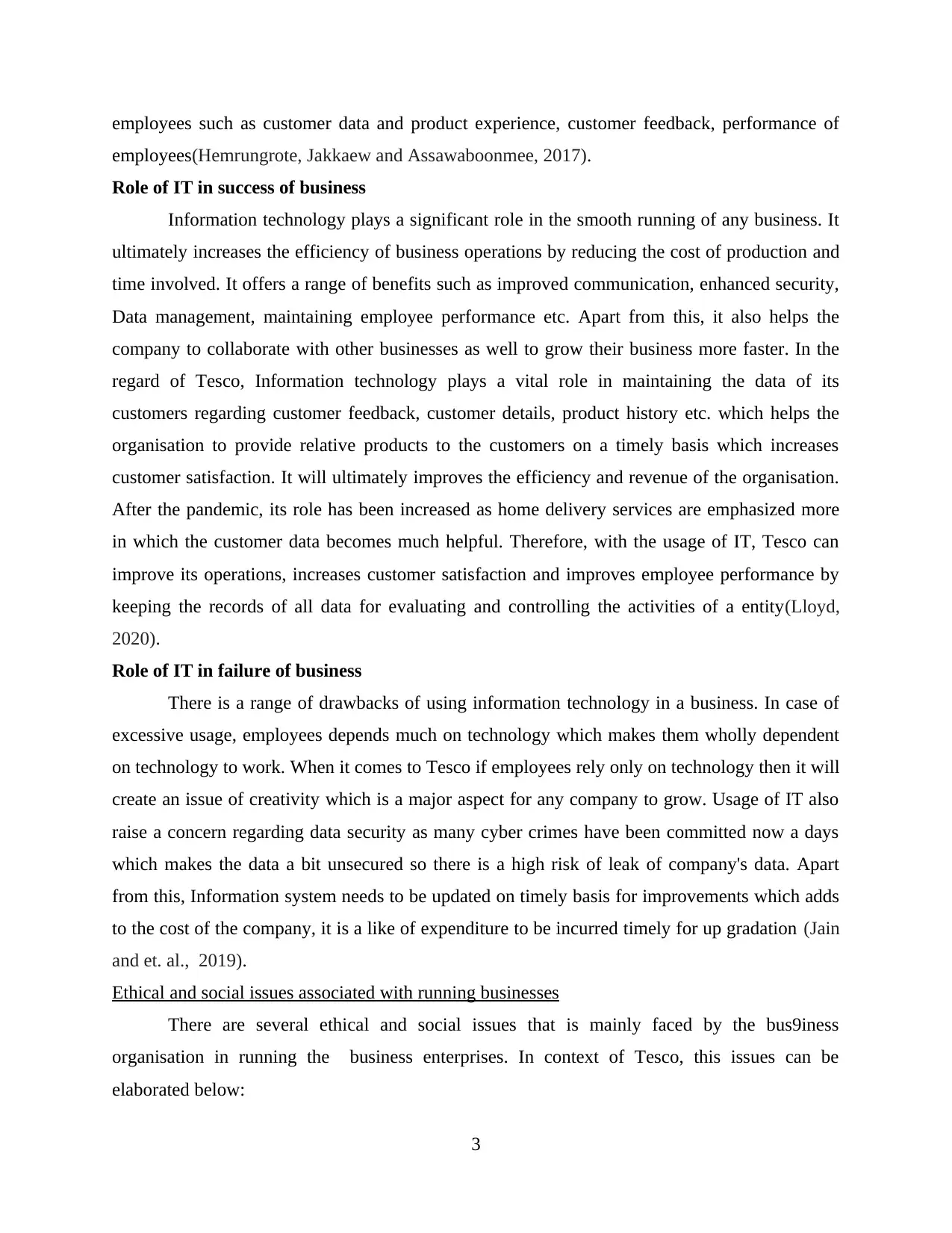
employees such as customer data and product experience, customer feedback, performance of
employees(Hemrungrote, Jakkaew and Assawaboonmee, 2017).
Role of IT in success of business
Information technology plays a significant role in the smooth running of any business. It
ultimately increases the efficiency of business operations by reducing the cost of production and
time involved. It offers a range of benefits such as improved communication, enhanced security,
Data management, maintaining employee performance etc. Apart from this, it also helps the
company to collaborate with other businesses as well to grow their business more faster. In the
regard of Tesco, Information technology plays a vital role in maintaining the data of its
customers regarding customer feedback, customer details, product history etc. which helps the
organisation to provide relative products to the customers on a timely basis which increases
customer satisfaction. It will ultimately improves the efficiency and revenue of the organisation.
After the pandemic, its role has been increased as home delivery services are emphasized more
in which the customer data becomes much helpful. Therefore, with the usage of IT, Tesco can
improve its operations, increases customer satisfaction and improves employee performance by
keeping the records of all data for evaluating and controlling the activities of a entity(Lloyd,
2020).
Role of IT in failure of business
There is a range of drawbacks of using information technology in a business. In case of
excessive usage, employees depends much on technology which makes them wholly dependent
on technology to work. When it comes to Tesco if employees rely only on technology then it will
create an issue of creativity which is a major aspect for any company to grow. Usage of IT also
raise a concern regarding data security as many cyber crimes have been committed now a days
which makes the data a bit unsecured so there is a high risk of leak of company's data. Apart
from this, Information system needs to be updated on timely basis for improvements which adds
to the cost of the company, it is a like of expenditure to be incurred timely for up gradation (Jain
and et. al., 2019).
Ethical and social issues associated with running businesses
There are several ethical and social issues that is mainly faced by the bus9iness
organisation in running the business enterprises. In context of Tesco, this issues can be
elaborated below:
3
employees(Hemrungrote, Jakkaew and Assawaboonmee, 2017).
Role of IT in success of business
Information technology plays a significant role in the smooth running of any business. It
ultimately increases the efficiency of business operations by reducing the cost of production and
time involved. It offers a range of benefits such as improved communication, enhanced security,
Data management, maintaining employee performance etc. Apart from this, it also helps the
company to collaborate with other businesses as well to grow their business more faster. In the
regard of Tesco, Information technology plays a vital role in maintaining the data of its
customers regarding customer feedback, customer details, product history etc. which helps the
organisation to provide relative products to the customers on a timely basis which increases
customer satisfaction. It will ultimately improves the efficiency and revenue of the organisation.
After the pandemic, its role has been increased as home delivery services are emphasized more
in which the customer data becomes much helpful. Therefore, with the usage of IT, Tesco can
improve its operations, increases customer satisfaction and improves employee performance by
keeping the records of all data for evaluating and controlling the activities of a entity(Lloyd,
2020).
Role of IT in failure of business
There is a range of drawbacks of using information technology in a business. In case of
excessive usage, employees depends much on technology which makes them wholly dependent
on technology to work. When it comes to Tesco if employees rely only on technology then it will
create an issue of creativity which is a major aspect for any company to grow. Usage of IT also
raise a concern regarding data security as many cyber crimes have been committed now a days
which makes the data a bit unsecured so there is a high risk of leak of company's data. Apart
from this, Information system needs to be updated on timely basis for improvements which adds
to the cost of the company, it is a like of expenditure to be incurred timely for up gradation (Jain
and et. al., 2019).
Ethical and social issues associated with running businesses
There are several ethical and social issues that is mainly faced by the bus9iness
organisation in running the business enterprises. In context of Tesco, this issues can be
elaborated below:
3
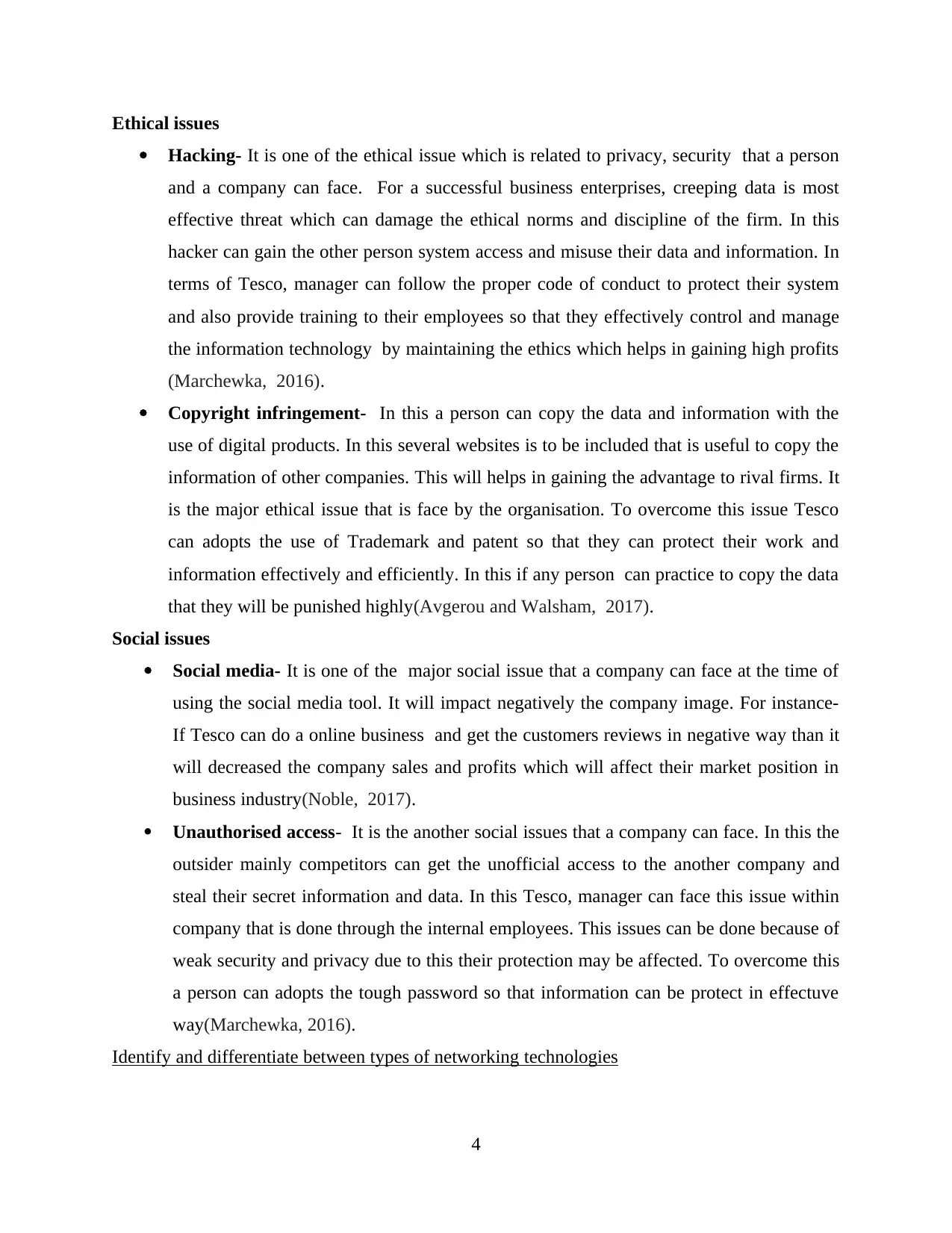
Ethical issues
Hacking- It is one of the ethical issue which is related to privacy, security that a person
and a company can face. For a successful business enterprises, creeping data is most
effective threat which can damage the ethical norms and discipline of the firm. In this
hacker can gain the other person system access and misuse their data and information. In
terms of Tesco, manager can follow the proper code of conduct to protect their system
and also provide training to their employees so that they effectively control and manage
the information technology by maintaining the ethics which helps in gaining high profits
(Marchewka, 2016).
Copyright infringement- In this a person can copy the data and information with the
use of digital products. In this several websites is to be included that is useful to copy the
information of other companies. This will helps in gaining the advantage to rival firms. It
is the major ethical issue that is face by the organisation. To overcome this issue Tesco
can adopts the use of Trademark and patent so that they can protect their work and
information effectively and efficiently. In this if any person can practice to copy the data
that they will be punished highly(Avgerou and Walsham, 2017).
Social issues
Social media- It is one of the major social issue that a company can face at the time of
using the social media tool. It will impact negatively the company image. For instance-
If Tesco can do a online business and get the customers reviews in negative way than it
will decreased the company sales and profits which will affect their market position in
business industry(Noble, 2017).
Unauthorised access- It is the another social issues that a company can face. In this the
outsider mainly competitors can get the unofficial access to the another company and
steal their secret information and data. In this Tesco, manager can face this issue within
company that is done through the internal employees. This issues can be done because of
weak security and privacy due to this their protection may be affected. To overcome this
a person can adopts the tough password so that information can be protect in effectuve
way(Marchewka, 2016).
Identify and differentiate between types of networking technologies
4
Hacking- It is one of the ethical issue which is related to privacy, security that a person
and a company can face. For a successful business enterprises, creeping data is most
effective threat which can damage the ethical norms and discipline of the firm. In this
hacker can gain the other person system access and misuse their data and information. In
terms of Tesco, manager can follow the proper code of conduct to protect their system
and also provide training to their employees so that they effectively control and manage
the information technology by maintaining the ethics which helps in gaining high profits
(Marchewka, 2016).
Copyright infringement- In this a person can copy the data and information with the
use of digital products. In this several websites is to be included that is useful to copy the
information of other companies. This will helps in gaining the advantage to rival firms. It
is the major ethical issue that is face by the organisation. To overcome this issue Tesco
can adopts the use of Trademark and patent so that they can protect their work and
information effectively and efficiently. In this if any person can practice to copy the data
that they will be punished highly(Avgerou and Walsham, 2017).
Social issues
Social media- It is one of the major social issue that a company can face at the time of
using the social media tool. It will impact negatively the company image. For instance-
If Tesco can do a online business and get the customers reviews in negative way than it
will decreased the company sales and profits which will affect their market position in
business industry(Noble, 2017).
Unauthorised access- It is the another social issues that a company can face. In this the
outsider mainly competitors can get the unofficial access to the another company and
steal their secret information and data. In this Tesco, manager can face this issue within
company that is done through the internal employees. This issues can be done because of
weak security and privacy due to this their protection may be affected. To overcome this
a person can adopts the tough password so that information can be protect in effectuve
way(Marchewka, 2016).
Identify and differentiate between types of networking technologies
4
⊘ This is a preview!⊘
Do you want full access?
Subscribe today to unlock all pages.

Trusted by 1+ million students worldwide
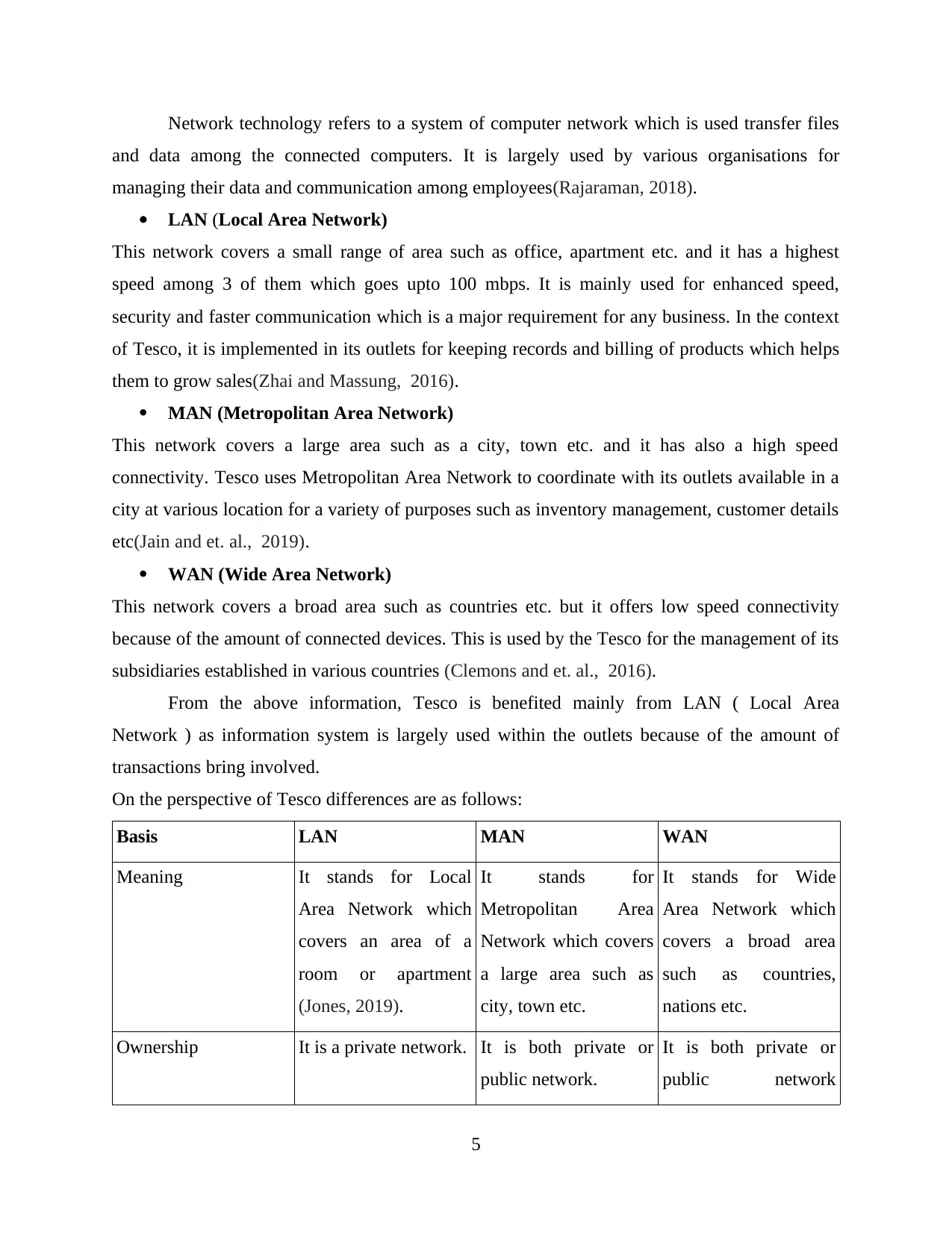
Network technology refers to a system of computer network which is used transfer files
and data among the connected computers. It is largely used by various organisations for
managing their data and communication among employees(Rajaraman, 2018).
LAN (Local Area Network)
This network covers a small range of area such as office, apartment etc. and it has a highest
speed among 3 of them which goes upto 100 mbps. It is mainly used for enhanced speed,
security and faster communication which is a major requirement for any business. In the context
of Tesco, it is implemented in its outlets for keeping records and billing of products which helps
them to grow sales(Zhai and Massung, 2016).
MAN (Metropolitan Area Network)
This network covers a large area such as a city, town etc. and it has also a high speed
connectivity. Tesco uses Metropolitan Area Network to coordinate with its outlets available in a
city at various location for a variety of purposes such as inventory management, customer details
etc(Jain and et. al., 2019).
WAN (Wide Area Network)
This network covers a broad area such as countries etc. but it offers low speed connectivity
because of the amount of connected devices. This is used by the Tesco for the management of its
subsidiaries established in various countries (Clemons and et. al., 2016).
From the above information, Tesco is benefited mainly from LAN ( Local Area
Network ) as information system is largely used within the outlets because of the amount of
transactions bring involved.
On the perspective of Tesco differences are as follows:
Basis LAN MAN WAN
Meaning It stands for Local
Area Network which
covers an area of a
room or apartment
(Jones, 2019).
It stands for
Metropolitan Area
Network which covers
a large area such as
city, town etc.
It stands for Wide
Area Network which
covers a broad area
such as countries,
nations etc.
Ownership It is a private network. It is both private or
public network.
It is both private or
public network
5
and data among the connected computers. It is largely used by various organisations for
managing their data and communication among employees(Rajaraman, 2018).
LAN (Local Area Network)
This network covers a small range of area such as office, apartment etc. and it has a highest
speed among 3 of them which goes upto 100 mbps. It is mainly used for enhanced speed,
security and faster communication which is a major requirement for any business. In the context
of Tesco, it is implemented in its outlets for keeping records and billing of products which helps
them to grow sales(Zhai and Massung, 2016).
MAN (Metropolitan Area Network)
This network covers a large area such as a city, town etc. and it has also a high speed
connectivity. Tesco uses Metropolitan Area Network to coordinate with its outlets available in a
city at various location for a variety of purposes such as inventory management, customer details
etc(Jain and et. al., 2019).
WAN (Wide Area Network)
This network covers a broad area such as countries etc. but it offers low speed connectivity
because of the amount of connected devices. This is used by the Tesco for the management of its
subsidiaries established in various countries (Clemons and et. al., 2016).
From the above information, Tesco is benefited mainly from LAN ( Local Area
Network ) as information system is largely used within the outlets because of the amount of
transactions bring involved.
On the perspective of Tesco differences are as follows:
Basis LAN MAN WAN
Meaning It stands for Local
Area Network which
covers an area of a
room or apartment
(Jones, 2019).
It stands for
Metropolitan Area
Network which covers
a large area such as
city, town etc.
It stands for Wide
Area Network which
covers a broad area
such as countries,
nations etc.
Ownership It is a private network. It is both private or
public network.
It is both private or
public network
5
Paraphrase This Document
Need a fresh take? Get an instant paraphrase of this document with our AI Paraphraser
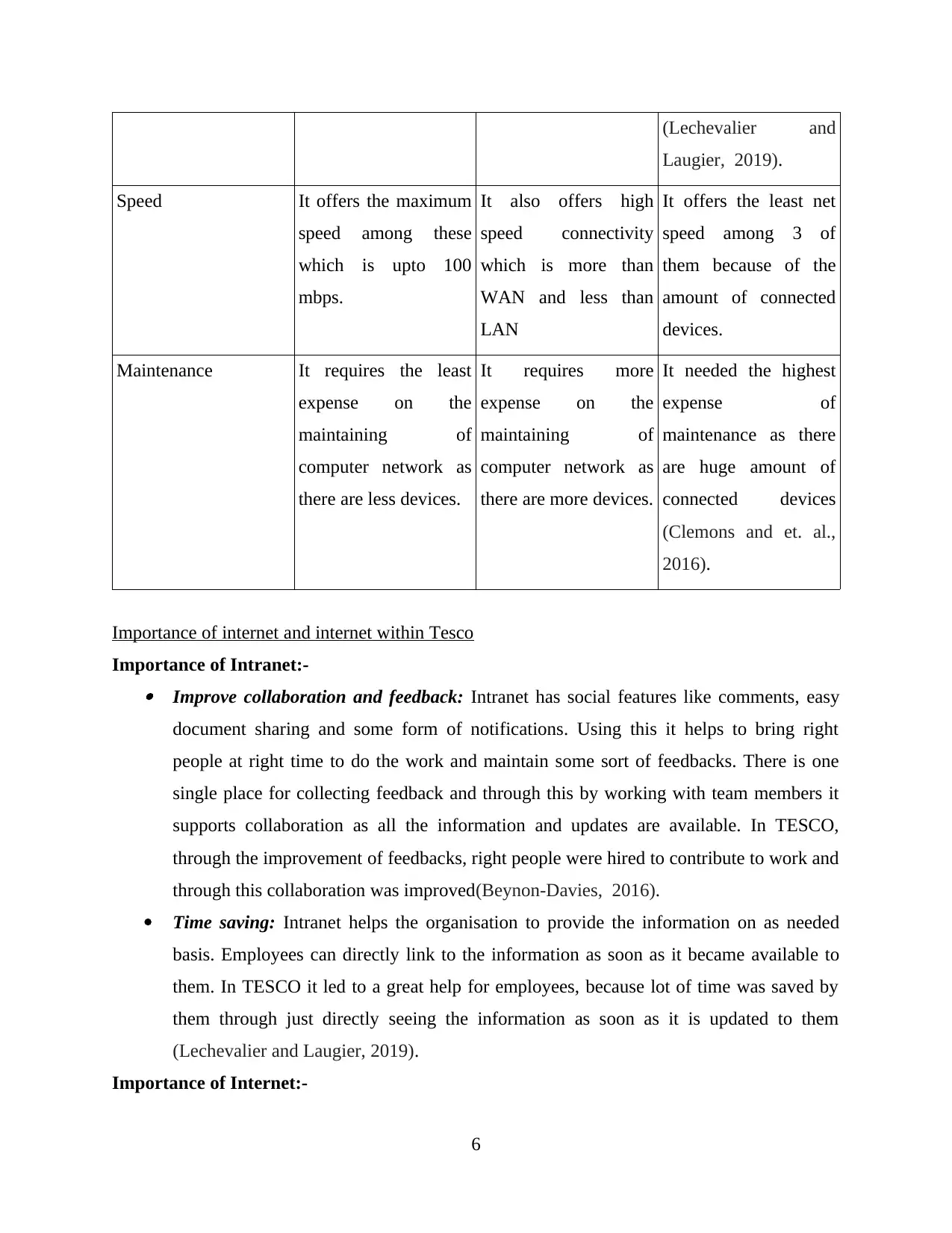
(Lechevalier and
Laugier, 2019).
Speed It offers the maximum
speed among these
which is upto 100
mbps.
It also offers high
speed connectivity
which is more than
WAN and less than
LAN
It offers the least net
speed among 3 of
them because of the
amount of connected
devices.
Maintenance It requires the least
expense on the
maintaining of
computer network as
there are less devices.
It requires more
expense on the
maintaining of
computer network as
there are more devices.
It needed the highest
expense of
maintenance as there
are huge amount of
connected devices
(Clemons and et. al.,
2016).
Importance of internet and internet within Tesco
Importance of Intranet:- Improve collaboration and feedback: Intranet has social features like comments, easy
document sharing and some form of notifications. Using this it helps to bring right
people at right time to do the work and maintain some sort of feedbacks. There is one
single place for collecting feedback and through this by working with team members it
supports collaboration as all the information and updates are available. In TESCO,
through the improvement of feedbacks, right people were hired to contribute to work and
through this collaboration was improved(Beynon-Davies, 2016).
Time saving: Intranet helps the organisation to provide the information on as needed
basis. Employees can directly link to the information as soon as it became available to
them. In TESCO it led to a great help for employees, because lot of time was saved by
them through just directly seeing the information as soon as it is updated to them
(Lechevalier and Laugier, 2019).
Importance of Internet:-
6
Laugier, 2019).
Speed It offers the maximum
speed among these
which is upto 100
mbps.
It also offers high
speed connectivity
which is more than
WAN and less than
LAN
It offers the least net
speed among 3 of
them because of the
amount of connected
devices.
Maintenance It requires the least
expense on the
maintaining of
computer network as
there are less devices.
It requires more
expense on the
maintaining of
computer network as
there are more devices.
It needed the highest
expense of
maintenance as there
are huge amount of
connected devices
(Clemons and et. al.,
2016).
Importance of internet and internet within Tesco
Importance of Intranet:- Improve collaboration and feedback: Intranet has social features like comments, easy
document sharing and some form of notifications. Using this it helps to bring right
people at right time to do the work and maintain some sort of feedbacks. There is one
single place for collecting feedback and through this by working with team members it
supports collaboration as all the information and updates are available. In TESCO,
through the improvement of feedbacks, right people were hired to contribute to work and
through this collaboration was improved(Beynon-Davies, 2016).
Time saving: Intranet helps the organisation to provide the information on as needed
basis. Employees can directly link to the information as soon as it became available to
them. In TESCO it led to a great help for employees, because lot of time was saved by
them through just directly seeing the information as soon as it is updated to them
(Lechevalier and Laugier, 2019).
Importance of Internet:-
6
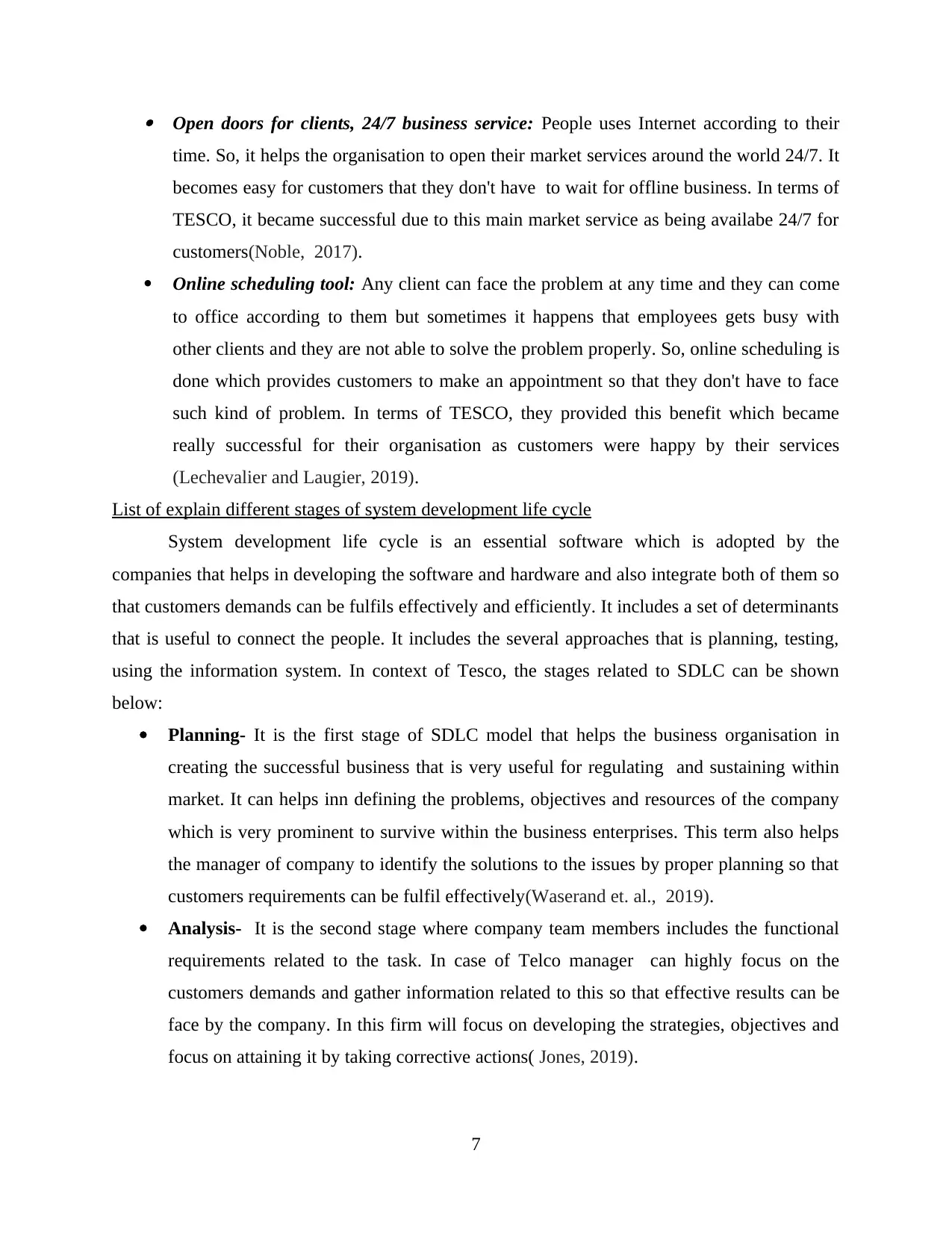
Open doors for clients, 24/7 business service: People uses Internet according to their
time. So, it helps the organisation to open their market services around the world 24/7. It
becomes easy for customers that they don't have to wait for offline business. In terms of
TESCO, it became successful due to this main market service as being availabe 24/7 for
customers(Noble, 2017).
Online scheduling tool: Any client can face the problem at any time and they can come
to office according to them but sometimes it happens that employees gets busy with
other clients and they are not able to solve the problem properly. So, online scheduling is
done which provides customers to make an appointment so that they don't have to face
such kind of problem. In terms of TESCO, they provided this benefit which became
really successful for their organisation as customers were happy by their services
(Lechevalier and Laugier, 2019).
List of explain different stages of system development life cycle
System development life cycle is an essential software which is adopted by the
companies that helps in developing the software and hardware and also integrate both of them so
that customers demands can be fulfils effectively and efficiently. It includes a set of determinants
that is useful to connect the people. It includes the several approaches that is planning, testing,
using the information system. In context of Tesco, the stages related to SDLC can be shown
below:
Planning- It is the first stage of SDLC model that helps the business organisation in
creating the successful business that is very useful for regulating and sustaining within
market. It can helps inn defining the problems, objectives and resources of the company
which is very prominent to survive within the business enterprises. This term also helps
the manager of company to identify the solutions to the issues by proper planning so that
customers requirements can be fulfil effectively(Waserand et. al., 2019).
Analysis- It is the second stage where company team members includes the functional
requirements related to the task. In case of Telco manager can highly focus on the
customers demands and gather information related to this so that effective results can be
face by the company. In this firm will focus on developing the strategies, objectives and
focus on attaining it by taking corrective actions( Jones, 2019).
7
time. So, it helps the organisation to open their market services around the world 24/7. It
becomes easy for customers that they don't have to wait for offline business. In terms of
TESCO, it became successful due to this main market service as being availabe 24/7 for
customers(Noble, 2017).
Online scheduling tool: Any client can face the problem at any time and they can come
to office according to them but sometimes it happens that employees gets busy with
other clients and they are not able to solve the problem properly. So, online scheduling is
done which provides customers to make an appointment so that they don't have to face
such kind of problem. In terms of TESCO, they provided this benefit which became
really successful for their organisation as customers were happy by their services
(Lechevalier and Laugier, 2019).
List of explain different stages of system development life cycle
System development life cycle is an essential software which is adopted by the
companies that helps in developing the software and hardware and also integrate both of them so
that customers demands can be fulfils effectively and efficiently. It includes a set of determinants
that is useful to connect the people. It includes the several approaches that is planning, testing,
using the information system. In context of Tesco, the stages related to SDLC can be shown
below:
Planning- It is the first stage of SDLC model that helps the business organisation in
creating the successful business that is very useful for regulating and sustaining within
market. It can helps inn defining the problems, objectives and resources of the company
which is very prominent to survive within the business enterprises. This term also helps
the manager of company to identify the solutions to the issues by proper planning so that
customers requirements can be fulfil effectively(Waserand et. al., 2019).
Analysis- It is the second stage where company team members includes the functional
requirements related to the task. In case of Telco manager can highly focus on the
customers demands and gather information related to this so that effective results can be
face by the company. In this firm will focus on developing the strategies, objectives and
focus on attaining it by taking corrective actions( Jones, 2019).
7
⊘ This is a preview!⊘
Do you want full access?
Subscribe today to unlock all pages.

Trusted by 1+ million students worldwide
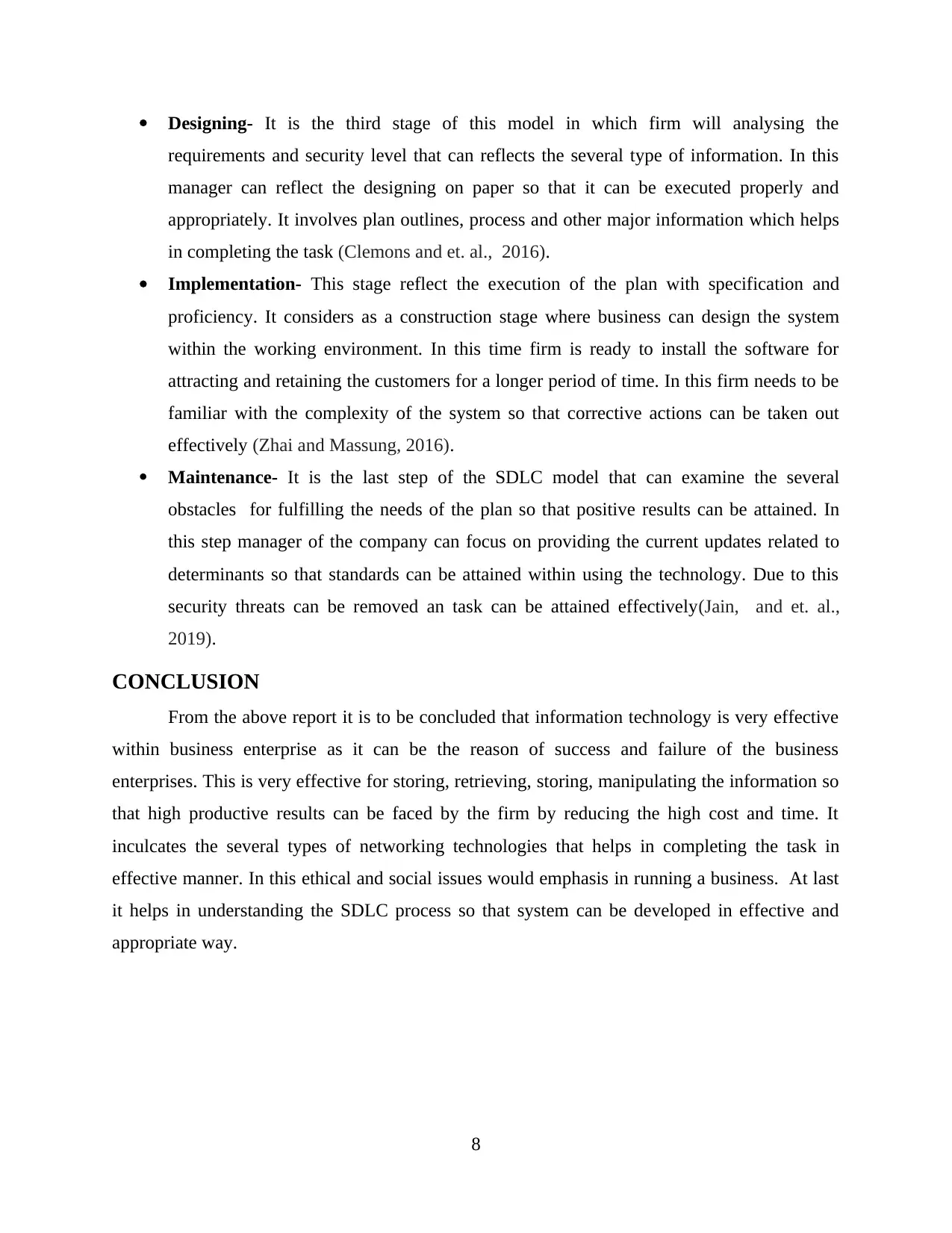
Designing- It is the third stage of this model in which firm will analysing the
requirements and security level that can reflects the several type of information. In this
manager can reflect the designing on paper so that it can be executed properly and
appropriately. It involves plan outlines, process and other major information which helps
in completing the task (Clemons and et. al., 2016).
Implementation- This stage reflect the execution of the plan with specification and
proficiency. It considers as a construction stage where business can design the system
within the working environment. In this time firm is ready to install the software for
attracting and retaining the customers for a longer period of time. In this firm needs to be
familiar with the complexity of the system so that corrective actions can be taken out
effectively (Zhai and Massung, 2016).
Maintenance- It is the last step of the SDLC model that can examine the several
obstacles for fulfilling the needs of the plan so that positive results can be attained. In
this step manager of the company can focus on providing the current updates related to
determinants so that standards can be attained within using the technology. Due to this
security threats can be removed an task can be attained effectively(Jain, and et. al.,
2019).
CONCLUSION
From the above report it is to be concluded that information technology is very effective
within business enterprise as it can be the reason of success and failure of the business
enterprises. This is very effective for storing, retrieving, storing, manipulating the information so
that high productive results can be faced by the firm by reducing the high cost and time. It
inculcates the several types of networking technologies that helps in completing the task in
effective manner. In this ethical and social issues would emphasis in running a business. At last
it helps in understanding the SDLC process so that system can be developed in effective and
appropriate way.
8
requirements and security level that can reflects the several type of information. In this
manager can reflect the designing on paper so that it can be executed properly and
appropriately. It involves plan outlines, process and other major information which helps
in completing the task (Clemons and et. al., 2016).
Implementation- This stage reflect the execution of the plan with specification and
proficiency. It considers as a construction stage where business can design the system
within the working environment. In this time firm is ready to install the software for
attracting and retaining the customers for a longer period of time. In this firm needs to be
familiar with the complexity of the system so that corrective actions can be taken out
effectively (Zhai and Massung, 2016).
Maintenance- It is the last step of the SDLC model that can examine the several
obstacles for fulfilling the needs of the plan so that positive results can be attained. In
this step manager of the company can focus on providing the current updates related to
determinants so that standards can be attained within using the technology. Due to this
security threats can be removed an task can be attained effectively(Jain, and et. al.,
2019).
CONCLUSION
From the above report it is to be concluded that information technology is very effective
within business enterprise as it can be the reason of success and failure of the business
enterprises. This is very effective for storing, retrieving, storing, manipulating the information so
that high productive results can be faced by the firm by reducing the high cost and time. It
inculcates the several types of networking technologies that helps in completing the task in
effective manner. In this ethical and social issues would emphasis in running a business. At last
it helps in understanding the SDLC process so that system can be developed in effective and
appropriate way.
8
Paraphrase This Document
Need a fresh take? Get an instant paraphrase of this document with our AI Paraphraser
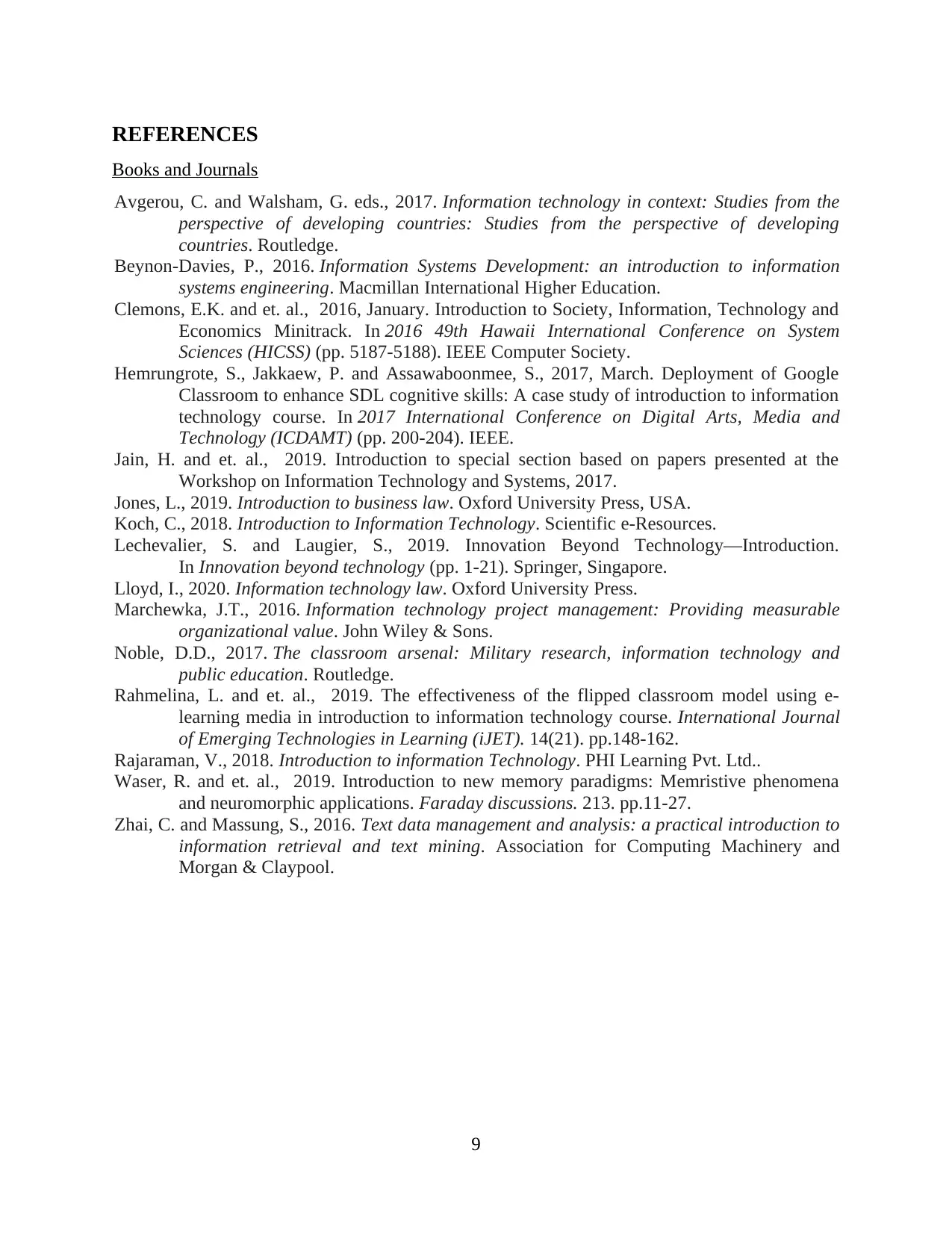
REFERENCES
Books and Journals
Avgerou, C. and Walsham, G. eds., 2017. Information technology in context: Studies from the
perspective of developing countries: Studies from the perspective of developing
countries. Routledge.
Beynon-Davies, P., 2016. Information Systems Development: an introduction to information
systems engineering. Macmillan International Higher Education.
Clemons, E.K. and et. al., 2016, January. Introduction to Society, Information, Technology and
Economics Minitrack. In 2016 49th Hawaii International Conference on System
Sciences (HICSS) (pp. 5187-5188). IEEE Computer Society.
Hemrungrote, S., Jakkaew, P. and Assawaboonmee, S., 2017, March. Deployment of Google
Classroom to enhance SDL cognitive skills: A case study of introduction to information
technology course. In 2017 International Conference on Digital Arts, Media and
Technology (ICDAMT) (pp. 200-204). IEEE.
Jain, H. and et. al., 2019. Introduction to special section based on papers presented at the
Workshop on Information Technology and Systems, 2017.
Jones, L., 2019. Introduction to business law. Oxford University Press, USA.
Koch, C., 2018. Introduction to Information Technology. Scientific e-Resources.
Lechevalier, S. and Laugier, S., 2019. Innovation Beyond Technology—Introduction.
In Innovation beyond technology (pp. 1-21). Springer, Singapore.
Lloyd, I., 2020. Information technology law. Oxford University Press.
Marchewka, J.T., 2016. Information technology project management: Providing measurable
organizational value. John Wiley & Sons.
Noble, D.D., 2017. The classroom arsenal: Military research, information technology and
public education. Routledge.
Rahmelina, L. and et. al., 2019. The effectiveness of the flipped classroom model using e-
learning media in introduction to information technology course. International Journal
of Emerging Technologies in Learning (iJET). 14(21). pp.148-162.
Rajaraman, V., 2018. Introduction to information Technology. PHI Learning Pvt. Ltd..
Waser, R. and et. al., 2019. Introduction to new memory paradigms: Memristive phenomena
and neuromorphic applications. Faraday discussions. 213. pp.11-27.
Zhai, C. and Massung, S., 2016. Text data management and analysis: a practical introduction to
information retrieval and text mining. Association for Computing Machinery and
Morgan & Claypool.
9
Books and Journals
Avgerou, C. and Walsham, G. eds., 2017. Information technology in context: Studies from the
perspective of developing countries: Studies from the perspective of developing
countries. Routledge.
Beynon-Davies, P., 2016. Information Systems Development: an introduction to information
systems engineering. Macmillan International Higher Education.
Clemons, E.K. and et. al., 2016, January. Introduction to Society, Information, Technology and
Economics Minitrack. In 2016 49th Hawaii International Conference on System
Sciences (HICSS) (pp. 5187-5188). IEEE Computer Society.
Hemrungrote, S., Jakkaew, P. and Assawaboonmee, S., 2017, March. Deployment of Google
Classroom to enhance SDL cognitive skills: A case study of introduction to information
technology course. In 2017 International Conference on Digital Arts, Media and
Technology (ICDAMT) (pp. 200-204). IEEE.
Jain, H. and et. al., 2019. Introduction to special section based on papers presented at the
Workshop on Information Technology and Systems, 2017.
Jones, L., 2019. Introduction to business law. Oxford University Press, USA.
Koch, C., 2018. Introduction to Information Technology. Scientific e-Resources.
Lechevalier, S. and Laugier, S., 2019. Innovation Beyond Technology—Introduction.
In Innovation beyond technology (pp. 1-21). Springer, Singapore.
Lloyd, I., 2020. Information technology law. Oxford University Press.
Marchewka, J.T., 2016. Information technology project management: Providing measurable
organizational value. John Wiley & Sons.
Noble, D.D., 2017. The classroom arsenal: Military research, information technology and
public education. Routledge.
Rahmelina, L. and et. al., 2019. The effectiveness of the flipped classroom model using e-
learning media in introduction to information technology course. International Journal
of Emerging Technologies in Learning (iJET). 14(21). pp.148-162.
Rajaraman, V., 2018. Introduction to information Technology. PHI Learning Pvt. Ltd..
Waser, R. and et. al., 2019. Introduction to new memory paradigms: Memristive phenomena
and neuromorphic applications. Faraday discussions. 213. pp.11-27.
Zhai, C. and Massung, S., 2016. Text data management and analysis: a practical introduction to
information retrieval and text mining. Association for Computing Machinery and
Morgan & Claypool.
9
1 out of 11
Related Documents
Your All-in-One AI-Powered Toolkit for Academic Success.
+13062052269
info@desklib.com
Available 24*7 on WhatsApp / Email
![[object Object]](/_next/static/media/star-bottom.7253800d.svg)
Unlock your academic potential
Copyright © 2020–2025 A2Z Services. All Rights Reserved. Developed and managed by ZUCOL.




